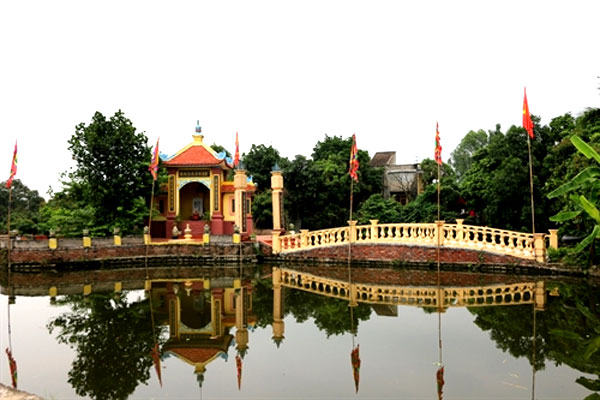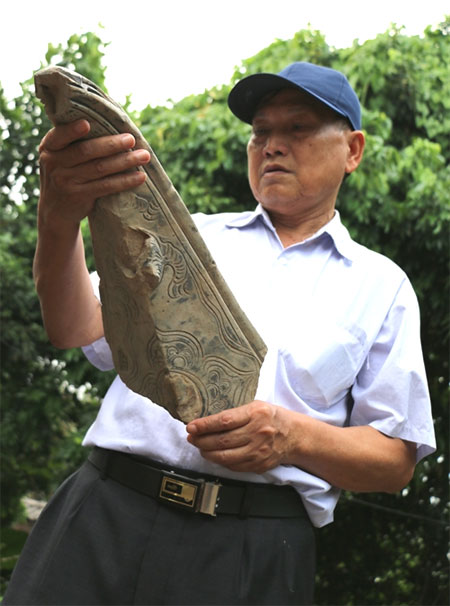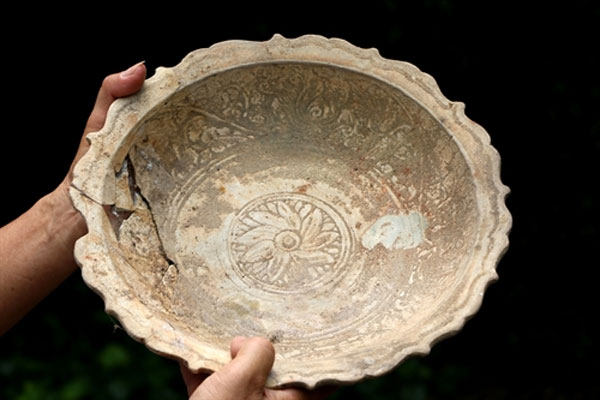VietNamNet Bridge – On a mid-summer day with 40-degree Celsius heat, we return to Quang Tien Hamlet in Gia Loc District, 70km south of Ha Noi. The houses along the road from Hai Duong City to the village in Gia Loc District are scattered under the shade of longan trees.
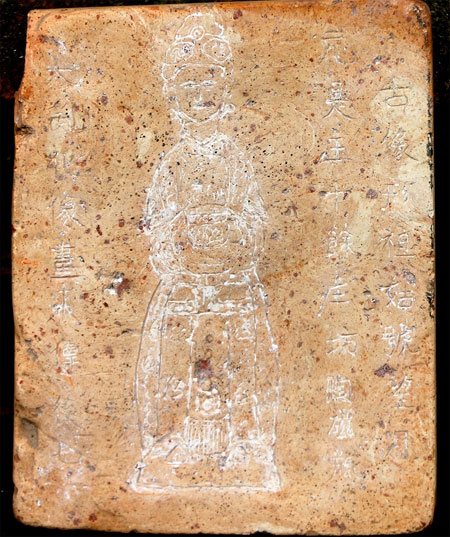
|
|
Queen of ceramics: Lady Bui Thi Hy (right) was also sketched on another brick because, as it was explained in the accompanying letters, the original statue must be destroyed due to war. Photos: Doan Tung/VNS
|
The whole road runs along a man-made channel sandwiched between the road and villages. To get to one’s house, you need to cross a bridge. Needless to say, the whole area looks so peaceful and lovely. Further into the village, the roads, sadly, have all recently been cemented, intertwined with emerald still ponds without any fences.
Walking around the village, I secretly wished that other villages would keep cool with this system of little ponds during the hot summer.
This year, the lotus suffered and the pond in front of Bui Duc Loi’s house in Quang Tien did not bloom. Still, the sight of giant lotus leaves and their green colour quenched our thirst for nature under the scorching sun.
The house looked the same as it did when I visited the family nine years ago to look for the artefacts of their ancestor, Lady Bui Thi Hy, who, according to local archaeologist Tang Ba Hoanh, was the Lady Master of ceramics. She created and exported a large amount of household and decorative ceramics overseas in the 15th century.
This time, more important artefacts have been discovered. Official excavations by the Hai Duong Museum found a corner of a building with inscriptions on it and two bricks. The bricks not only bear the inscription in Han Chinese with her name on it, but also, more excitingly, a drawing of her and her grandfather.
A ceramic corner of a building was found on June 13, 2013. Showing us the artefacts, archaeologist and former director of the Hai Duong Museum Tang Ba Hoanh said, "This line reads, ‘the ninth year of Hong Duc reign, made by Bui Thi Hy.’” Hoanh still works full speed at 76 years of age.
It’s not only one brick. The image of the Bui clan founder, General Bui Quoc Hung, who was one of 18 other comrades-in-arm of King Le Loi in the 15th century and attended the historic Lung Nhai Sworn Ceremony in 1416, was also found on another brick. A picture of that image is hung on the family’s altar. Loi is a descendent of both General Bui Quoc Hung and Lady Bui Thi Hy.
Image on a brick
In our previous article, we have written about how Hoanh reached the conclusion that Bui Thi Hy was the creator of the Annam Vase at the Topkapi Palace Museum in Turkey, based on the Bui family’s historical records. http://vietnamnews.vn/sunday/features/169239/mystery-woman-of-the-chu-dau-ceramics.html
Since then, more excavations have been conducted, and more artefacts bearing the name of Bui Thi Hy have been found.
In May 2008, Hoanh said he studied the celestial tower in front of the village pagoda and found an inscription on it that read, “In the year of the Rat, 1492, Bui Thi Hy built the pagoda with local people.”
An official excavation held by the Hai Duong Museum in 2011 — which dug up Bui Duc Loi’s front yard, where an incense tower (for placing incense and praying to the deceased) is located — found two bricks with sketches of a man wearing the royal hat with wings, and another brick depicting a woman.
Both bricks have inscriptions on them, which Hoanh translated as follows: “Ancient statue of ancestor Bui Quoc Hung, founding father of the Le Dynasty.”
The other brick’s inscription reads, “Image of the founding lady, titled Vong Nguyet (Aspiring Moon), chairwoman of more than 10 ceramic guilds. Due to war, the statue must be destroyed so an image has to be copied for future generations.”
According to the bronze round tray that contains the entire writing, believed to be copied from the original stone stele, Lady Bui Thi Hy was known by the title Vong Nguyet.
A Facebook post from Hai Duong Museum reads, “The image on this newly-found brick bears great resemblance to the statue of a lady found in the sunken ships of Cu Lao Cham, currently owned by the National Museum of History. Due to the latest finding after the excavation, we strongly suggest that we give the ceramic statue at the National Museum of History the correct name of the original.”
Again, the word “Hy” came up in an inscription, just like the same word on the famous Annam Vase.
We brought the question to Han-Chinese expert Tran Nho Thin of Ha Noi’s National University and asked him to compare the two usages of the word “Hy” on the vase and on the ceramic corner found in Loi’s yard.
“They mean the same,” he wrote in an email. But the styles are different.
And the meaning? He insisted that the word “Hy” here means joyfully created. In the case of the Annam Vase, it means “joyfully painted”, and in the ceramic corner, “joyfully made.”
Up for debate
“This time, can they say it’s joyfully created, again?” asks Hoanh. He’s trying to say that the same person created the Annam Vase in Turkey and this corner of a building found in Loi’s pond. And that person is Lady Bui Thi Hy.
The dispute about how one shall understand the meaning of this word has been going on for quite a long time. The most prominent opponents of the Lady have been the scholars in Ha Noi and the National Museum of History.
Nguyen Dinh Chien of the museum reportedly told a number of newspapers that the family’s annals were written unlike other family annals, with some of the words written in a newer style.
After my first article was published, I received an email from Roxanna Brown from Bangkok University’s Southeast Asian Ceramics Museum, saying that “the green saucer" in my story that Loi told me he found at his pond "was actually a Thai celadon.”
I was shocked to hear that, but no sooner had we been able to clarify this subject, I received a newsletter from the Bangkok Museum saying that she was found dead in a police cell awaiting trial.
According to Wikipedia, Brown was arrested on May 9, 2008 for alleged wire fraud when she arrived in the United States to deliver a lecture at an Asian art symposium at the University of Washington. She was found dead in her cell at the Federal Detention Center in SeaTac on May 14.
While researching for this article, I came across a private collector’s website that says Brown had doubts that the inscription on the Annam Vase was correctly translated.
“I wish that other scholars would come here to Hai Duong to inspect the artefacts and provide official assessments,” Hoanh said.
He started out as an accountant and took night classes at Ha Noi University in the 1960s. He later returned to the same school and graduated from the history department in 1978.
Work eventually brought him to work at the province’s Historical Council, which determined during a 1983 excavation that Chu Dau was a ceramic center in Hai Duong in the 15th century.
Home-schooled in Han script, he could read Han and Nom scripts well. His college thesis was about the interpretation of flower motifs in ancient literature on scholastic steles of Viet Nam. Professor Ha Van Tan was his advisor and Professor Tran Quoc Vuong wrote comments on his thesis.
“Even during a conference to brief our excavation findings, someone just stood up and said, ‘Don’t believe them. It’s all false,” Hoanh said.
“It’s very sad that way. I think we need to be up for healthy debate about the findings, and I would like more international scholars to provide their interpretation.”
So far, no international scholars have provided an interpretation, but in the visitor’s book at Loi’s house, some Japanese have left comments. A group of Japanese scholars from Hiroshima University have written in the book in Vietnamese and Chinese.
“I was very honoured to visit the tomb of Lady Bui Thi Hy and see many artefacts relating to her,” wrote Hasuko Tadashi of the Center for Southeast Asian Studies at Kyoto University. “It is a delight to meet her descendants and see that her legacy has been protected by the family.”
Further searching
The quest still continues, and Loi said that one of his neighbours was reportedly keeping a giant dragon head, excavated from another family’s pond.
“He puts it on his family altar and will not let anyone get into his house to see it,” Loi said.
“I believe it’s the same as the dragon adorning the sun on top of the Le Temple in Thanh Hoa Province,” Hoanh added.
As such, Loi said, “I’ll look for a time to come visit his house and maybe try to see if any inscription is written under it. Unfortunately, I can’t read Han script, but I can bring my camera.”
Outside in his yard, his 90-year-old mother looks distantly into the mid-day summer sun.
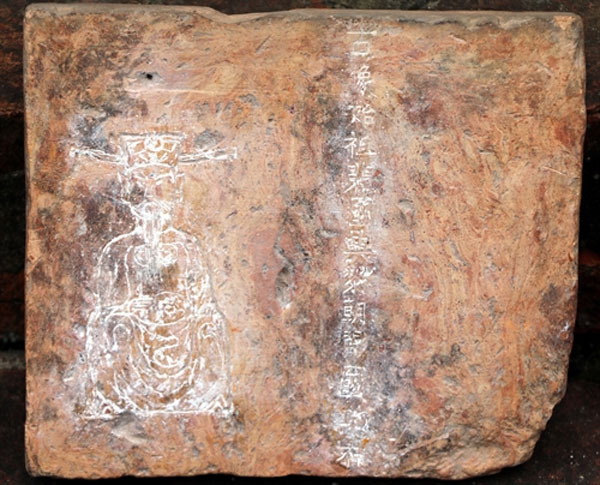
|
|
Founder: The brick with a sketch and inscription that reads, "Bui Quoc Hung (who sided with Le Loi to fight the Ming) founded the Le Dynasty".
In tribute: The newly-built temple dedicated to Lady Bui Thi Hy, the chair of over 10 ceramic guilds that produced and exported far and wide.
Areca nut on top of a lime vase.
Mystery: Archaeologist Tang Ba Hoanh reads the inscription on the building corner.
Ceramic bowl with firing faults. Its green colour has faded.
|
Nguyen My Ha
| related news |
|
Con Son - Kiep Bac: Museum of Vietnamese belief and culture |
VNS
